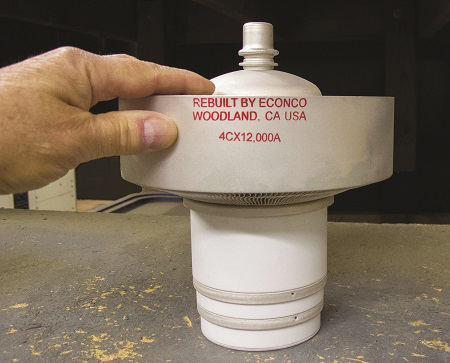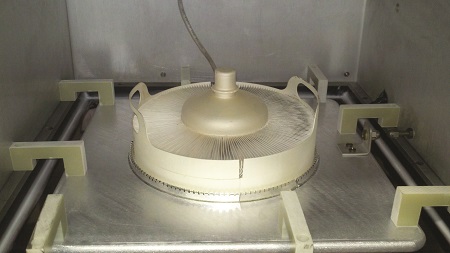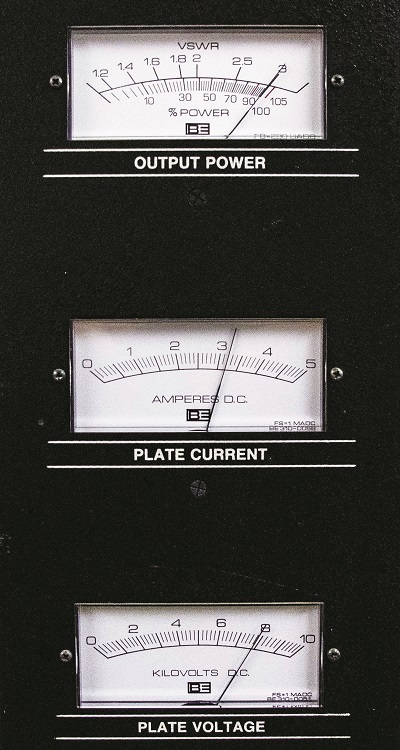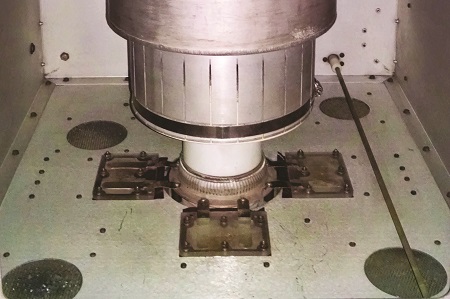|
In the
Feb. 1 issue, we discussed what
you'll find inside an electron tube
and its basic principles of
operation.
Now
let's talk about how that tube works
in an FM radio transmitter.
The key to amplification in a tube
is the control grid, the set of thin
wires between the filament and the
plate. You feed RF drive into this
grid, causing electron emission from
cathode to vary at the RF drive
frequency and amplitude. It is this
small voltage and power that
regulate a large electron flow at
much higher power. What we have been
talking about is a 3CX (triode)
tube.
 |
|
Fig. 1: This is a
newly rebuilt transmitter
tube. |
Then
comes a fourth element, making the
tube a 4CX. It is called a screen
grid and is another wire grid
between the control grid and the
plate. Its job is to pull electrons
toward the plate with a positive
voltage. Most electrons go past the
screen grid and to the plate.
Some electrons are captured by the
screen grid and become screen
current. Yes, it is an unintended
consequence of being in the right
place at the right time.
If
you use a Harris or similar FM
transmitter you know that the power
control is a screen voltage control.
With no screen voltage, the
transmitter typically makes about 20
percent of its normal power. You
adjust screen voltage upward to
increase power. It is as simple as
that.
Each transmitter design is
different. Sometimes the control
grid in these designs has 100 or
more volts of negative DC to help
bring all the parameters together
for best performance and efficiency.
In
Continental FM transmitters, the PA
(power amplifier) plate voltage,
screen voltage and RF drive are
adjusted simultaneously with the
raise/lower power control. This is
an elegant design but does not
easily compensate for tolerance
differences between individual
tubes, especially as they age.
Engineers with Continental
Electronics transmitters find
themselves changing taps on the
screen transformer to accommodate a
new or rebuilt tube with slightly
different characteristics than the
last tube. The idea is to get the
volts to current ratio where the
transmitter manufacturer designed it
to be. Higher-screen voltage means
higher PA current. Those
transmitters also have a PA bias
control that will help with
tube-to-tube differences.
 |
|
Fig. 2: Here's a
4CX20,000D tube in a Harris
FM transmitter. |
TUNING
You tune or "match" impedances
between the RF driver and the
control grid of the tube for minimum
reflected power to the RF driver.
Best not to try for maximum power
transfer as that could lead to
higher than desired reflected
power/VSWR on the driver stage. Tune
for lowest reflected power to keep
the driver stage happy. Then there
is power amplifier tuning where you
adjust for best tube efficiency by
again matching impedances. Watch all
the meters, not just the power
output. Tune toward minimum PA
current while adjusting for maximum
power output. Adjust screen voltage
to keep the PA current where the
transmitter manufacturer says it
should be for your power level.Once you have adjusted for
best efficiency, use a thermometer
to verify that the exhaust
temperature of the tube is within
specifications. Output power meters
on transmitters are relative
devices. Every transmitter has a
control to set the meter to read
whatever you want.
Set it to read 100 percent only when
the transmitter is running
correctly. Never use the
output power meter to determine
operating power. You might have
higher or lower actual power than is
shown on the station license.
There is a little-used, FCC-approved
procedure for using the
transmitter's power meter, but few
stations are equipped to do so. You
can verify transmitter power with a
calibrated Bird or Coaxial Dynamics
brand wattmeter, if you like.
An
FCC inspector will look at PA
voltage, PA current and rated
transmitter efficiency to determine
if the station is running legal
power. The station will pass or fail
an inspection accordingly.
You will find PA efficiency listed
on the factory checkout sheet for
the transmitter or in a graph in the
transmitter instruction manual. An
example is 8,000 volts x 3.4 amperes
= 27,200 watts x 79.1 percent PA
efficiency = 21,515 watts of
transmitter power output. The
station license allows as much as 5
percent over that or 10 percent
under that to remain legal.
 |
|
Fig. 3: Watch all
the meters, not just the
power output. |
TUBE TOO SMALL?
You have a 20 kW FM transmitter with
a 4CX15,000A tube. Does that make it
a bad design?No, the 15,000 watt tube
dissipation capability is for the
inefficiency of the power amplifier.
To put out 20,000 watts, the
transmitter might achieve 75 percent
PA efficiency. That means 26.7 kW of
high-voltage DC power is required to
enable the transmitter to achieve
20,000 watts of RF at its output.
The tube must lose 6.7 kW in heat
from the high-voltage supply plus
power lost in the control and screen
grid. Add to that the filament,
which is 6.3 volts at 160 amperes or
1,008 watts.
Eimac specifications show the tube
could develop as much as 36.5 kW
under the right conditions. That is
pushing the equation way too far, in
my opinion, and does not take into
account any mistuning. A transmitter
and tube might have to handle
antenna icing in winter conditions.
Poor matching because of that can
severely mistune a transmitter
causing the tube to dissipate more
power in an attempt to stay on the
air. Most transmitters have overload
and protection circuits to prevent
that.
FILAMENTS
Electron tubes wear out. The
filament is what wears. You've heard
it before, and I'll repeat it again.Best life from a tube comes
from proper filament management.
That means running the filament at
the rated voltage as indicated in
your transmitter manual or tube
specification sheet for 200 hours of
operation. Then drop it as low as
possible before there is a
significant reduction in emission,
which you see as lower transmitter
power.
You can easily double or triple a
tube's life by careful filament
voltage management. Some
transmitters have filament voltage
regulators to make up for power line
voltage variations. This is
especially helpful when power line
voltage sags frequently because of a
nearby factory or farm when electric
usage increases and decreases.
Tube emission and transmitter power
output will decrease as a tube nears
the end of its life. You should
adjust filament voltage upward to
compensate. It is time to replace
the tube when you are at 5 percent
over the rated filament voltage. It
is called "end of life."
PROBLEMS
If you have tuning trouble in a
transmitter, it is best to reduce PA
voltage or drive to keep the tube
within specification for
dissipation. If you look in a tube
spec book, you will see figures for
maximum control and screen grid
dissipation too. Sometimes, I've
disconnected one of the three leads
on the primary of a three-phase
power transformer when tuning and
troubleshooting. Do this with all
the power turned off! Typically the
PA voltage will drop to half. That
will put the output at one-quarter
power. Do the troubleshooting and
initial tuning before reconnecting
that third wire. That is a great way
of handling a problem without
burning up a tube.
 |
|
Fig. 4: A tube
cavity with 4CX20,000C |
MORE IS NOT BETTER
This is for transmitters with
solid-state RF drivers.
Just
because an FM transmitter
manufacturer recommends the PA tube
in your transmitter needs 350 watts
of drive, it doesn't mean that 400
watts is better. You can get into a
situation where PA efficiency will
suffer with more RF drive.
Do
your tuning to match what the
manufacturer test data shows. Your
numbers may be a bit off because you
have a different tube in the
transmitter. Adjust RF drive by
tweaking FM exciter power. You will
find that the tube efficiency is
poor when under driven. It will peak
and then drop off again as drive is
increased.
Find the sweet spot where PA
efficiency is best. You will know
that when PA current is low and
transmitter RF output is highest.
RECORD KEEPING
Keep tabs on what condition your
tubes are in when removed from
service.
You can
refer to a serial number on the
bottom, which is often difficult to
read.
Another way is to mark the tube with
a statement something like "makes 90
percent power." Do not mark on
the ceramic. Yes, ceramic is a
wonderful place for a pencil to
leave legible markings. Pencil lead
is a conductor and can easily help
start an arc-over when the tube is
returned to service. Pencil lead is
also difficult for a tube rebuilding
company to remove. Best to use a
liquid pen and indicate status on
the tube anode.
You'll be glad you did when you
return to a broken transmitter in
the middle of the night and can�t
remember which tube is good and
which one isn't.
DO IT RIGHT
My recommendation: Have one new or
rebuilt tube on the shelf for every
tube that is in service at the site.
Tubes are "wear" items and will wear
out or outright fail with time. It
is just a matter of when.
You
can't predict when a tube will need
replacing. Yes, a tube can get weak
so transmitter power falls off. It
can just quit in just seconds,
putting you in a bind to get a
replacement in a hurry.
Knowing the facts will help you get
the job done right.
Mark Persons W0MH is
Certified Professional Broadcast
Engineer by the Society of Broadcast
Engineers and has more than 30
years' experience. His website is
www.mwpersons.com. You can also see this article at
Radio World Magazine:
http://www.radioworld.com/article/going-tubing-find-the-sweet-spot/274894 |



